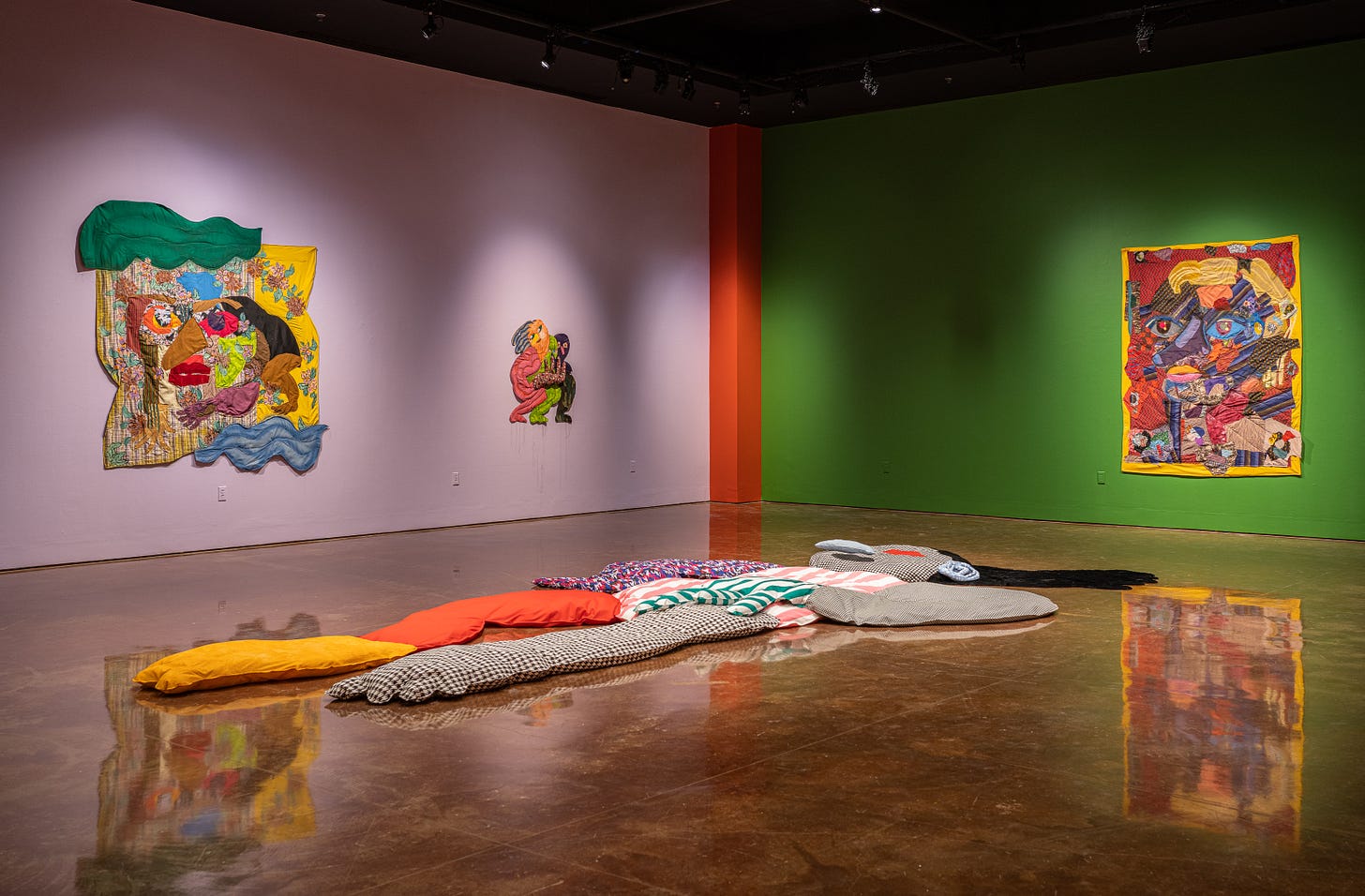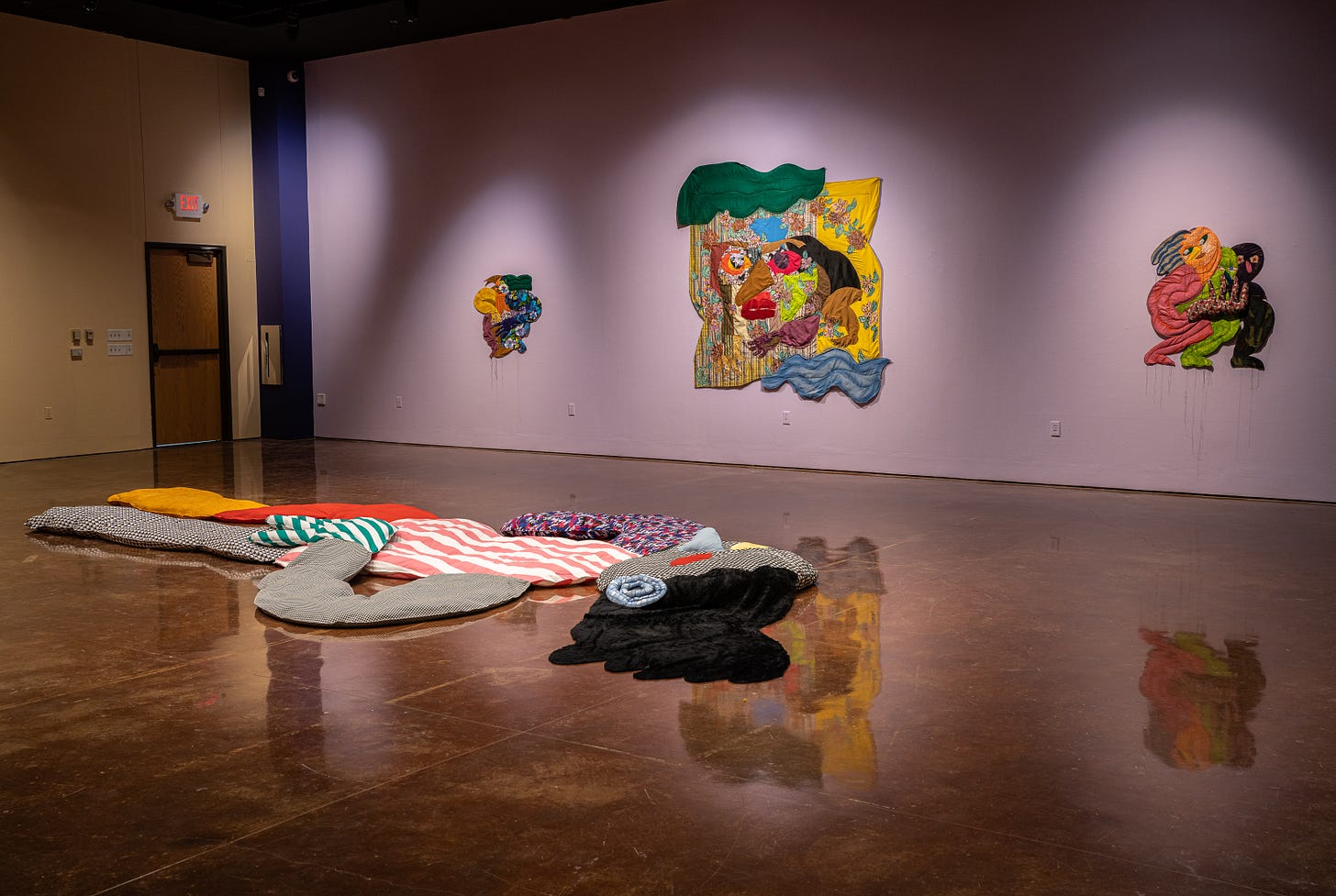Maria A. Guzmán Capron’s work is impossible to forget. Made of a motley mix of collaged and painted fabrics, her brightly-colored soft sculptures playfully tussle and prance across gallery walls. The fantastical, colorful figures that populate these artworks celebrate the artist’s own “loud and exotic” difference: Born in Milan, Italy to Colombian and Peruvian parents, she immigrated to Texas in her teens, and is now based in Oakland, California.
I first connected with Guzmán Capron in September 2021 when I was working on a review of her exhibition Olas Malcriadas (in English, “Naughty Waves”) at Texas State University for Hyperallergic. To prepare for the piece, and to get a better sense of her story and her practice, I sent the artist a handful of questions by email. Her answers were clear, honest, and sprinkled with a winking sense of humor that also feels present in her work: She referred to the characters in her pieces as “hot aliens,” after all!
I seem to have caught Guzmán Capron just before a pivotal burst of professional growth. Since our interview, her work has been featured in major exhibitions at the Blaffer Art Museum, SF MOMA, and El Museo del Barrio, among many others. Nowadays the artist incorporates other techniques into her practice like furniture making, and she creates her own patterned textiles. But our conversation from the fall of 2021 always stayed with me, so — with the artist’s generous permission — I’m sharing it here.

Lauren Moya Ford: The works in Olas Malcriadas are executed with hand and machine sewing techniques. What first brought you to sewing, and how did it enter your art practice?
Maria Guzmán Capron: I didn't have any background in sewing, but as an undergrad studying painting, I would use hot-glue to attach fabric cutouts to shapes made from cardboard and plywood. It was so exciting to not know how to use a material and to invent my own way, but at the heart of my experimentation was an earnest love and attraction for fabric itself. This led me to buy a cheap sewing machine and continue to experiment, creating costumes, masks, and soft-sculptures, and over nearly two decades of working with fabric, I have developed my own process for making that is at the core of my art practice.
LMF: You also work with bright, richly patterned and textured fabrics and paint. Where do these fabrics come from? Can you tell me about your integration of paint and fabric together in some pieces?
MGC: Choosing fabric is part of my artistic practice and I love to visit stores that sell a wide variety, from the tacky to the tasteful. When I choose fabric I follow my intuition, and also sift through layers of meaning, signs, and cultural signals alongside color, pattern and texture. My favorite place in the fabric store and the beginning of each visit is the sale bin, where all of the scraps and unwanted textiles are exiled.
When I start composing a piece, I build on the hierarchies and histories woven into fabric, often centering these cast-off textiles, intentionally allowing them to clash, sometimes emphasizing these contrasts and other times working to blend them seamlessly. I use fabric in an expressive, painterly way by layering color and pattern, and I use paint in a sculptural way, to bridge designs, to highlight a shape, curve, or facial expression, and to carve away and hide part
LMF: Your figures are not quite cartoonish, but their picaresque poses and loud colors lend them a sort of mischief and action potential. Where do these figures come from, and how do you consider them? Are they characters that recur throughout your work, personas, avatars, or something else?
MGC: The figures are shaped by the way I draw, and I think of them as brown bodies, my own brown body, but I have given them extra powers. They are beyond-human characters, flexing their powerful muscles, stretching belief with their extraordinary elasticity, and performing an otherworldly femininity. They’re hot aliens and they’re made out of fabric!
They are all different characters but they are all part of me and my community. They embody emotions, desire and my relationship to the world. I see myself in them but I also see my family, friends and even people I don’t like :). I make them incomplete; open-ended, but they become momentarily whole when someone engages with them by looking, feeling and conversing with the work.

LMF: In the press release for the show, you write about creating your own Brown Latinx identity, and you mention "an immigrant aesthetic that attempts to navigate belonging." Can you say more about creating your identity through your work, and about the immigrant aesthetic?
MGC: I am an immigrant. I was born in Italy and my parents are Peruvian and Colombian. I moved to Colombia at 14 and then the United States at 17, landing in suburban Texas midway through my junior year of high school without knowing any English. People recognized me as foreign without even speaking to me. I dressed in a different way and I could see it when comparing myself to the crowd of teenagers.
Clothing and the fabric it is made from carry these signals and meanings. I know that some people think that a few bright colors make an outfit loud and exotic, but that is how my family dresses; with a vivid color palette and floral patterns similar to what you see in my work.
This exuberance is familiar and comforting to me, but I know it can feel brash to others. I have sometimes tried to blend in, but I can’t hide the beautiful, loud Tunki (the national bird of Peru) that is part of me. When I make my work I speak of that tension: I show you my taste, my personality and the stress of fitting it in a new space. As an immigrant, a person, I want to belong. I want to be part of my community, but not by giving up what I am; instead, I want to be part of creating space for more differences.
My family would say I am “ni chicha ni limonada” (neither the sweet purple corn drink nor lemonade). I am a new thing and I want to signal with my textiles to other in-between people that they belong.
Maria Guzmán Capron’s solo exhibition Olas Malcriadas was organized by Rebecca Marino and was on view at Texas State Gallery from August 23 to November 12, 2021.






